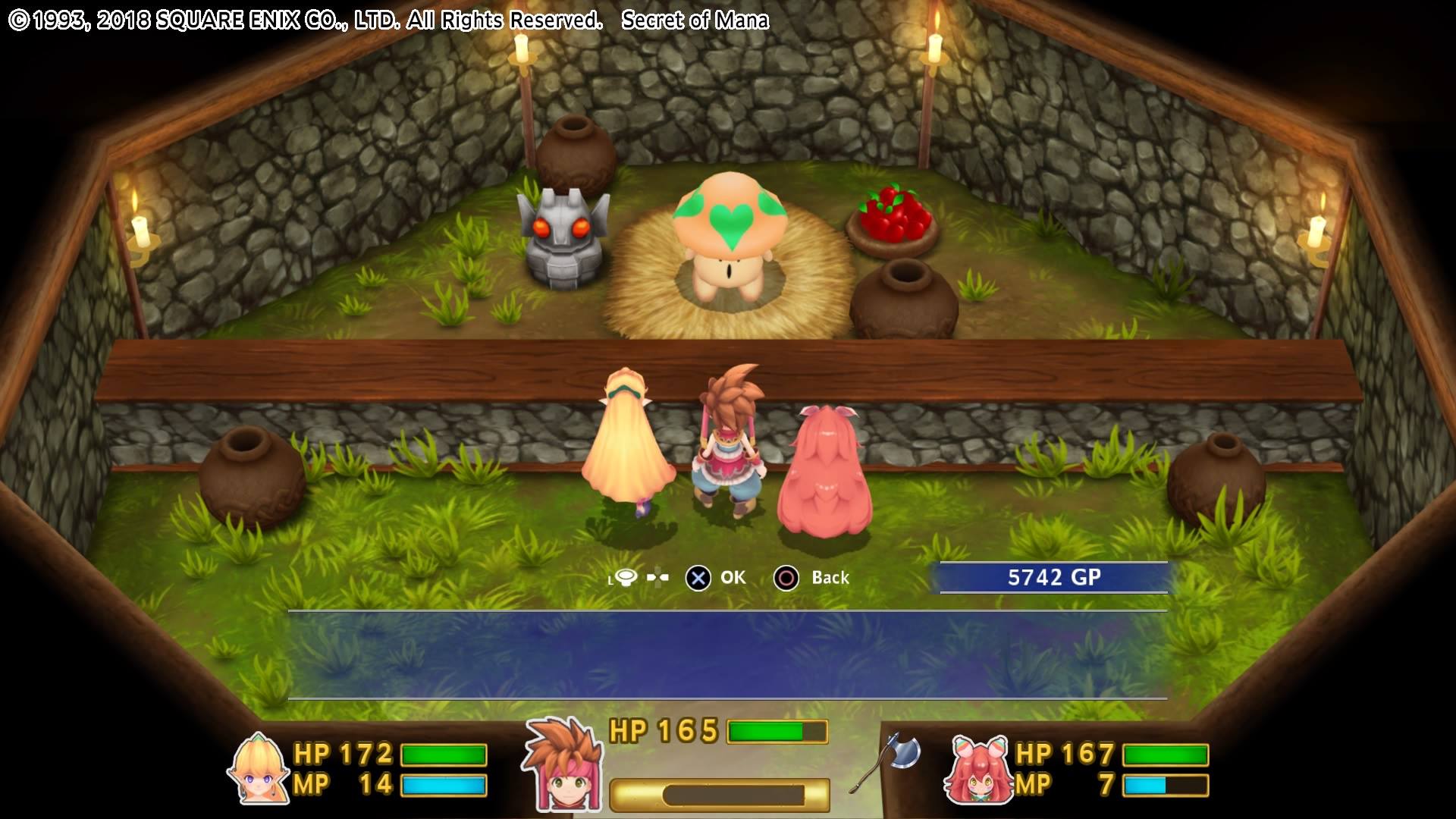Platforms:
PS Vita, ,
Released:
February 15, 2018
Publisher:
Square Enix
Developer:
Square Enix
Nostalgia is a funny thing. At a glance, it is that longing for the days-gone-by; a desire to relive those moments that our subconscious deems joyous and special. Going deeper, nostalgia is a feeling of loss, of distance, and, in some ways, of grief. You may get the feeling of nostalgia when thinking about a lost grandparent or pet. You experience nostalgia when hearing songs you associate with a prominent event in your life, such as a wedding (or break-up). You get the feeling when remembering the days of playing your Super Nintendo in your bedroom, with the volume down and the glow of your boxy television lighting your room. Nostalgia is a feeling that most humans treasure, even though it encompasses such a wide range of emotions. When I first saw the trailer for the Secret of Mana remake, my heart was instantly burdened by an intense nostalgia.
This is a series I used to care about so much, brought back to life and onto PlayStation 4. A series I loved so much, I downloaded a fan-made translation of the sequel (the unreleased-in-the-west Seiken Densetsu 3, or Secret of Mana 2) to play on an emulator, because the fact that I couldn’t legally obtain it in Australia drove me mad (and, technically, to a life of crime). My expectations were high, owing to the intense nostalgia that Secret of Mana draws out in me, and I was eager to see if the remake could deliver on those feelings.
Let’s start with the story. Plot-wise, Secret of Mana isn’t the most robust. It takes the classic tale of “the chosen one” and tasks you, Randi (or whatever name you want to call him), with finding and sealing the Mana Seeds to prevent the destruction of the world. A familiar tale, but with stories like this it comes down to execution and emotional impact. With a range of supporting characters, sages, and elemental sprites, the journey takes Randi and party across a wide range of environments and pits them against a variety of well-designed bosses. Many of the twists and turns are predictable, with the standard slew of betrayals, dark magic, and ancient beasts present to dot the i’s and cross the t’s.
I definitely remember Secret of Mana having a more engaging story as a child, but in this remaster everything feels flat. At times the back-and-forth across the zones, and stop-start pacing of the plot, feels like a boss rush game with a dialed in plot. While the underlying narrative is interesting, the game failed to captivate me the same way it did 20 years ago. Nostalgia, in this case, betrayed me.

From the get-go, the dialogue and emotional range seem to be targeted at a younger audience. Cheesy one-liners, awkward prose, and some downright bad scripting hinders engagement with the characters and plot. Indeed, being so turned off by the dialogue and voices (more on that below), I found it difficult to follow the game’s direction in the opening hours, and needed to rely on memory of the original to find my way.
I believe a lot of the story misses can be chalked up to the immensely underwhelming voice acting. Square Enix have done a major overhaul in the dialogue by giving every single voice line a real voice. These range in quality; supporting characters Gemma and Luka’s roles are excellently performed, while the party characters Randi, Primm, and Popoi are grating and childish. This shotgun blast of quality is a big distraction, and a complete undermining of the nostalgic 16-bit era text-based dialogue that I didn’t know I missed until this remaster. A particular dishonorable mention goes to the townsfolk and shopkeeper’s voices, which sound like they were performed by someone out-of-breath using a speaker phone. In my opinion, the voices should have been left by the wayside; if it ain’t broke, don’t fix it.
“…comes out looking like a high-res 3DS game, especially noticeable in the human character designs, with weak animation applied to the close-up dialogue scenes.”
Graphically, the game has clearly had a lot of attention given to it. The 16-bit sprites have been remade in fully animated 3D. The models are colourful and attractive, but fall short of the standards we know now. Compared to Square Enix’s latest 16-bit tributes I Am Setsuna and Lost Sphear, Secret of Mana remake just does not hold up. Where Square Enix managed to capture the essence of the old-school in Lost Sphear, unfortunately Secret of Mana comes out looking like a higher resolution 3DS game. These shortcomings are especially noticeable in the human character designs, with weak animation applied to the close-up dialogue scenes. These scenes, new to the 2018 remake, draw attention to the graphical shortcomings and, instead of enhancing the story and dialogue, highlight the lack of depth and emotion in the characters.
On the flip side, the graphical update to the enemies and environments don’t disappoint as much as the character models. Each environment is filled with enemies that reflect their habitats, and the vibrant colours of the landscapes are attractive and a major step up from the SNES original. The rose coloured glasses of memory held the visuals of Secret of Mana in high regard for me, and it’s pleasing to see that the developers put the effort it to try and capture that memory in reality. When you gain access to the ”airship” in the game (hint in the screens below), the world becomes fully accessible and the visual richness of the map really hits home. Going back and watching footage of the original and then playing the remake really shows how far the world visuals have come.
Secret of Mana’s greatest strengths lie in the combat and soundtrack. Battles with enemies are performed in real-time, a major innovation for Square in the 90’s, and remains a shining quality of the game. Modern technology has expanded the angles of attack, giving the player more strategic options when facing their foes, which comes in handy against some particularly nasty boss fights. Combat is challenging and scales fairly sharply, especially in the early hours of the game, meaning grinding through scores of Rabites, Werewolves, and Tomato Men is required to keep up the pace.
The downside: the ring system. Secret of Mana features a ring menu system that is used in-and-out of battle to equip items, select spells, and check stats. It took me a few solid hours to get a grasp of navigating the rings of each character; switching between them is confusing, and the little direction given in the menus makes finding what you need difficult. The lack of a quest log or journal, outside of a small blurb about your next destination, means finding your way is sometimes just trial-and-error across multiple screens.
“…I seriously had some crazy nostalgic heartache when hearing the songs again.”
The music, man, the MUSIC; I seriously had some crazy nostalgic heartache when hearing the songs again. Secret of Mana, for me, has always had some of the strongest musical scores in Square’s 16-bit output, and the remastered tracks are simply delightful. The option to flick between the original audio and remastered audio is a beautiful touch that triggered some big feels from me; a trend that I hope Square Enix continues as they revive more of their older IPs.
From the happy whimsical tunes of the various towns and settlements, to the frantic themes of the boss fights, the score of Secret of Mana has stood the test of time. As a musical person myself, I often find myself whistling video game themes from titles I’ve long forgotten. While playing through the game again, more than one of the motifs jumped out at me as jingles I still get stuck in my head. Music and memory are so intrinsically linked, and it’s beautiful when games can trigger such memory… such nostalgia.

Finally: the game’s performance. Secret of Mana straddles the line of smooth 60fps fluidity and intense frame crunching. From time to time the game slows down, especially when there are multiple enemies and spells on screen at a time. It isn’t a huge issue, but busier screens tend to grind the game down. There were some occasional game crashes, but the game’s robust auto-save system kept me from losing any progress, which is a huge saving grace. While a game crashing is never a good sign, I only experienced crashing a handful of times across the 20+ hour experience and, when compared to some other games of that length, didn’t have any destructive side effects other than simply launching the game again and loading up the auto-save.
Positive:
- Great combat, updated to suit modern controllers
- Timeless musical score
- Well designed bosses, and vibrantly colourful environments
Negative:
- Thin plot, hindered by poor dialogue
- Bad voice acting
- Clumsy ring menu system
- Minor performance issues, including frame drops and game crashing
Will I try to platinum this game? Probably. Will I lose my mind if Square announces Secret of Mana 2 remake? Absolutely. However, at the end of the day, I don’t think the Secret of Mana remake lives up to the original’s legacy. While the skeleton of the much-loved classic is there, the meat on the bones fails to satisfy. That said, the updates to combat, the musical score, and environmental graphics are truly impressive, and worth a dabble for any fan of Square Enix’s old school titles.











